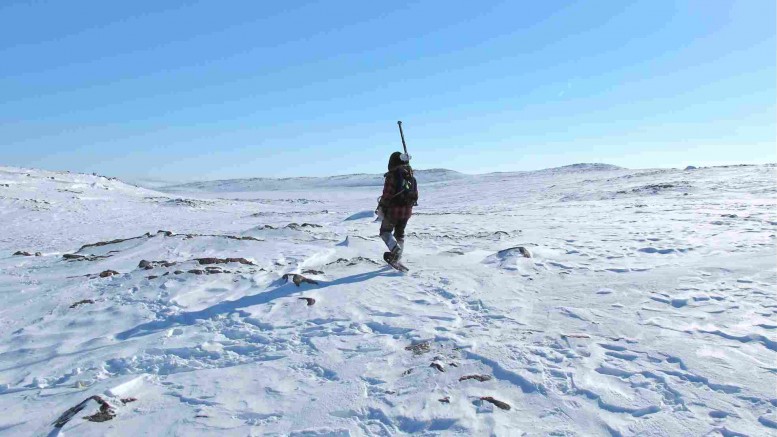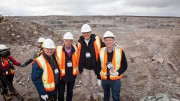The year 2010 would have been tough for Peregrine Diamonds (PGD-T) to top, even in the best of markets.
The company made 34 new kimberlite discoveries at its 49%-owned Chidliak project, on Baffin Island, last year — many of them by prospecting.
By comparison, in 2011, the company and 51% partner BHP Billiton (BHP-N, BLT-L) discovered only nine (for a total of 59 kimberlites). But Peregrine president Brooke Clements points out that, four years into exploration at Chidliak, it’s natural for the discovery rate to slow down.
“The easier ones have been found, now they’re just a little tougher to find,” he says.
The lower number of discoveries this year is also indicative of a shift in focus at the project, where Peregrine remains operator. While the company did devote a lot of time and energy to exploration, it was also busy evaluating kimberlites identified as having economic potential and preparing to move some of those pipes into the bulk-sampling stage next year.
Investors have had high expectations for Chidliak, located 120 km from Iqaluit, ever since the release of spectacular early microdiamond results from the CH-6 kimberlite in late 2009 that implied a grade of 6.3 carats per tonne.
“I think a lot of people this year were really hoping that we were going to make this big bell-ringing new discovery,” says Peregrine president Brooke Clements.
Although it didn’t happen, Clements is still hopeful such a discovery is in the cards.
The partners won’t have their 2012 program or budget finalized until December or January, but it will include bulk sampling of between three and five kimberlites, slated to begin in the first quarter, as well as continued exploration for new kimberlites.
Aiming to collect a 200-carat parcel from each kimberlite chosen for bulk sampling, the partners will have enough stones for a valuation and to get a better handle on grade, both essential clues to the viability of a mine at Chidliak.
“It won’t give us the type of diamond value you need to make a production decision, but it will certainly give us a diamond result in the ballpark to crystallize the priority — we want to determine we’re in the game,” Clements says.
In an interview in October, Clements said the 0.9-hectare CH-6 and 1-hectare CH-7 will definitely see bulk sampling.
Last November, a 47.2-tonne mini-bulk sample from CH-6 returned a grade of 1.04 carats per tonne. When combined with previous samples, the average grade of CH-6 is 2.84 carats per tonne. In December 2010, a 14.1-tonne sample from CH-7 yielded variable grades from each of four phases of the kimberlite, from 2.03 carats per tonne (Unit D) to 6.81 carats per tonne (Unit A).
One to three other kimberlites will also be part of the bulk-sampling program. The final decision will rest on the results of samples from three nearby pipes: the 4-hectare CH-31, and the smaller CH-44 and CH-45 (0.4 and 0.3 hectares, respectively). All five kimberlites chosen or being considered for bulk sampling are located in the Southern Focus area of the 8,580-sq.-km project.
“What we would hope to find is that valuations of the diamonds in these three or more pipes that we sample next year are such that the rock value clearly indicates even with just those kimberlites, you could potentially have a mine,” Clements explains.
The company would at the same time continue with exploration, and advance other kimberlites with economic potential to try to make the project bigger.
Next year’s program will be more expensive than this year’s (the partners spent around $18 million at Chidliak in 2011 with Peregrine funding its proportionate 49%), but the details won’t be sorted out until sampling results from CH-31, CH-44, and CH-45 are back from the lab.
Both the market and Peregrine are looking for bigger kimberlites at Chidliak. CH-31 is so far the most promising of the larger kimberlites. In 2010, an 840-kg sample from the kimberlite yielded five commercial-size (larger than 0.85 mm) stones weighing a total of 1.39 carats, including a 1.15-carat, clear, gem-quality diamond. (Overall, 233 diamonds larger than the 0.106-mm sieve size were recovered from four phases of CH-31.)
Also last year, a 312-kg sample from CH-44 yielded 910 diamonds larger than the 0.106-mm sieve size, including nine commercial-size diamonds weighing 0.45 carat. A 174-kg sample from CH-45 returned 158 diamonds larger than 0.106 mm, including two commercial-sized stones weighing 0.09 carat.
This past year, Peregrine took mini-bulk samples from two kimberlites: CH-31 (3.9 tonnes collected from drilling plus 1 tonne collected in 2010) and CH-28 (33.5 tonnes taken from surface).
At presstime, results from CH-6 and CH-7, CH-28, CH-31, CH44 and CH-45 were still to come. (CH-6 and CH-7 saw some drilling for geology and size in anticipation of bulk-sampling next year, but some of the material collected will be processed.)
In the fall, microdiamond results were released from CH-55 and CH-58 (both estimated at over 0.5 hectares) and from the smaller CH-52, estimated at 0.2 hectares. All yielded commercial-size diamonds from small samples, so the company says that follow-up work is warranted.
Some of the most exciting news from the Peregrine team this year actually came from Peregrine Metals — a subsidiary of Peregrine that went public in March 2010. (Shares of Peregrine Metals were distributed to Peregrine Diamonds shareholders — half a share for each Peregrine Diamonds share held — in October 2005.)
In July, Stillwater Mining (SWC.U-T, SWC-N) reached a deal to buy Peregrine Metals and its Altar copper-gold project in Argentina at a premium of 400% at the time of the bid. Stillwater completed the acquisition in October, paying out US$1.35 and 0.08136 of a Stillwater share for each Peregrine Metals share.
The company was completing a prefeasibility study at Altar, which has measured and indicated resources totalling 7.4 billion lbs. copper and 1.5 million oz. gold (at a 0.44% copper-equivalent grade) and inferred resources of 4.3 billion lbs. copper and 880,000 oz. gold.
Peregrine Metals and Peregrine Diamonds had their origins in the same private company, but in 2006, Peregrine Diamonds went public to advance its DO-27 kimberlite while the sister company remained private.
Clements says Peregrine’s focus right now is on Chidliak. However, the management team may look into other such opportunities in the future.
Peregrine’s nearby 100%-owned Qilaq project, where three kimberlites have so far been discovered, will also see some work next year.
With so much uncertainty in the markets, times are tough for explorers of all stripes. But Peregrine’s large shareholders are long-term, mine-oriented people, says Mike Westerlund, vice-president of investor relations and corporate communications. (Those large shareholders include Dundee Securities’ Ned Goodman and Peregrine CEO Eric Friedland.)
And Clements is optimistic about both the future of Chidliak and of the diamond industry.
“There are very few projects in the world that are at the defining moment stage right now,” he says.
“It’s really a good time for diamonds,” he continues pointing to the fundamentals — a growing demand in China coupled with a lack of new supply. “But in a recession, it’s not the first thing on people’s minds.”





Be the first to comment on "Peregrine preps Chidliak for bulk sampling"